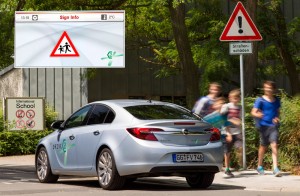- European cooperative mobility project with 47 partners successfully completed
- Car2X communication as a key tool of future traffic management
- Opel leads testing of interoperability of individual systems

An increase in road safety and traffic efficiency through vehicle communications (car2X) is one of the main aims of automobile manufacturers and politics. Together with 46 consortium partners, Opel has been testing the functionality, practicality and effectiveness of car2X under real conditions in DRIVE C2X, a cooperative mobility project co-funded by the European Commission. The consortium presented the results of the successfully completed project today, at its closing event in Berlin.
Opel has been carrying out R&D into intelligent systems for improving road safety and efficiency for several years. The communication between connected cars and the traffic infrastructure is one of the main areas of research. Car2X is a model of the future for intelligently controlled road management. In the last 42 months, DRIVE C2X has performed field tests in seven countries (Finland, France, Germany, Netherlands, Italy, Spain and Sweden). The goals were to demonstrate the advantages of the cooperative systems of each project partner, to avoid risks in traffic or prevent them from happening at all, and thus to achieve an effective improvement of traffic flow.
The systems tested included not only warnings of construction sites and traffic jams, approaching emergency vehicles, weather and road conditions, but also traffic sign information and systems that optimize traffic flow at traffic lights, or give early warning of hidden dangers and obstacles. Opel not only supplied a specially equipped Insignia with weather warning; the company also led the testing of the interoperability of the individual systems supplied by the participating manufacturers.
“It was important to find out whether the various cars could even communicate with each other, since each manufacturer uses different hard and software”, explains Opel electronics development engineer, Bernd Büchs. “Field tests in Helmond, Netherlands, demonstrated that the communication between vehicles functioned very well”.
The consortium tested the weather warning developed by Opel in Tampere, Finland. Sensors gathered data on along roads most affected by temperature, fog, rain or snow and informed the vehicles via car2X technology. During this testing Opel assessed the suitability of vehicle electronics systems for gathering data on risky conditions such as ice, and communicating this information to other car2X-vehicles as a localized warning.
Seemingly trivial details occasionally delivered the biggest learnings. For example, on country roads in Germany, signs that warn of wild animals crossing the road show a deer, while in Scandinavia the signs show a moose. The electronics in each vehicle must be adapted to such differences, so that the car reacts the same way in every country. In Finland and Sweden, the authorities also place great importance on avoiding accidents near schools with special warning signs and speed limits; these additional warning signs were transmitted to the vehicle via car2X. Car2X also had to respect the various legal requirements in the participating countries. Bernd Büchs: “In France, for example, the speed on motorways is 130 km/h, when it rains it is 110 km/h. The systems must consider differences such as this, as well as the corresponding laws in other countries”.
The automobile industry predicts that car2X will be market-ready in between two and five years’ time. The priorities are standardization, vehicle integration and ease of use. In addition, the technology must be affordable for the customer, since road users will only benefit from the advantages when as many drivers as possible use the systems. The reaction of the test drivers to the technology was very positive; the majority would use the systems and would be willing to pay an additional price for them.

